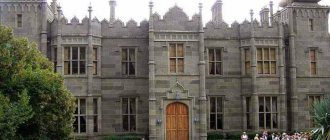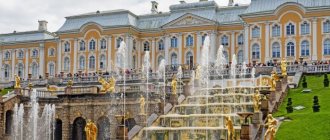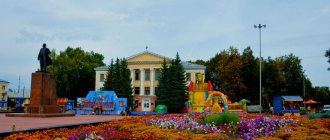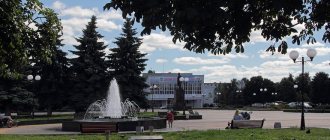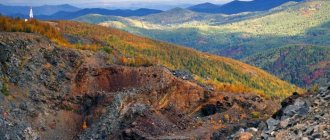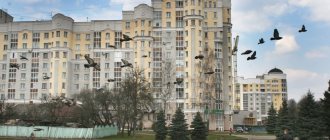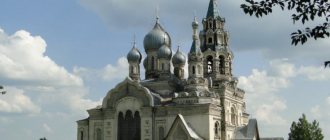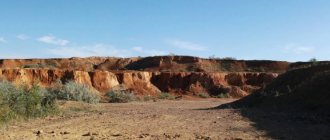Park Museum A.K. Tolstoy
The museum park named after Alexei Konstantinovich Tolstoy is located in the historical center of Bryansk, on Gagarin Boulevard.
The park is one of the oldest parks in the city.
In the center of the complex there is a monument to A.K. Tolstoy , which is located opposite the Russian Orthodox Church. Services are held regularly in the church, and anyone can visit it.
Throughout the territory there are wooden figures symbolizing various heroes of fairy tales, epics and children's stories. In the park you can see figures of Grandfather Mazai and hares, heads of heroes and even a whole fountain, designed in the form of a well, from which good fellows pump water.
During the warm season, the park hosts entertainment events and concerts, where various dance and vocal ensembles perform.
Recreation centers of the Bryansk region
The Bryansk region is located in the western part of Russia, on the border with Belarus and Ukraine. Within the country, it neighbors the Oryol, Kaluga and Smolensk regions, occupying an area of approximately 35,000 square kilometers.
Anyone who chooses the Bryansk region as their holiday destination will immediately find themselves right in the historical center of our country. That is why those who are true connoisseurs of historical and cultural heritage come here. Many large cities in the region have already celebrated their 500th anniversary, thanks to which you can admire unique historical sights. Also here you will be able to find numerous ancient architectural monuments of various styles, where buildings built in the classical style will coexist with wooden huts decorated with carvings.
Thanks to the unique nature of the Bryansk region, you can come here to relax as a “savage”, or stay in a village to get closer to the amazing local life and customs. You can also choose a recreation center or tourist center, which, thanks to the unique nature and local climate, has recently received a large number of guests. Natural and climatic conditions Since the Bryansk region is located in temperate latitudes, it experiences mild summers and cold winters. In July, the average air temperature is between +18+20 degrees, and in January -7-9 degrees. A significant part of the region’s territory is covered with forests, and since it is located in two natural zones at once, the Bryansk region is distinguished by its diverse and rich nature. Broad-leaved, mixed and coniferous forests are successfully combined with many kilometers of steppes. Cultural program By choosing the Bryansk region as a holiday destination, you will be able to fully enjoy the unique local nature and get acquainted with the historical values of the region. Most tourist centers offer their guests an entertainment program, which includes excursions and trips to interesting places in the region.
Trubachevsk
Having visited this city, tourists will learn that it was founded back in 975 and is included in the list of 115 ancient cities in Russia, which have the largest number of memorial architectural monuments. On the city's Cathedral Square there are such attractions as the Trinity Cathedral, as well as the Intercession and Transfiguration churches.
Ovstug - estate of the noble family Tyutchev
Here you can get a lot of new information about the life of the inhabitants of the estate - the Menshikovs, Naryshkins and Razumovskys. It was here that Tyutchev wrote many of his poems.
Dyatkovo Glass Factory
The city of Dyatkovo was founded in 1626, at first there was a village, which later, in 1810, became a village. In 1790, a crystal factory was built here, which gave impetus to the development of this settlement. The main attraction of the city is the Dyatkovo Crystal Museum, which displays a one-of-a-kind collection of ancient and modern crystal and glass. By visiting the crystal factory, you can not only watch how beautiful products are born, but also buy a souvenir as a keepsake, which is something almost everyone does.
Museum-Estate of A.K. Tolstoy
This family estate is famous for its wooden sculptures installed throughout the park. Depicted here are a carpenter, a cutter, a baker and a flour miller, a blacksmith and a glass blower, who personify the main crafts for which the Bryansk region is famous.
Holy Dormition Monastery in the village of Suponevo
On the banks of the Desna River, flowing in the village of Suponevo, Prince Roman Mikhailovich turned to the icon of the Mother of God and she helped him regain his sight. Later he founded a monastery on this site.
Klimovo village
In this very place the Slavic lands of Russia, Ukraine and Belarus converge, in honor of which the Friendship Monument was erected in 1975. Since then, a festival has been held here every year, which is attended by numerous representatives of these countries. In addition to these historical attractions, guests of the Bryansk region can visit a large number of churches and monasteries located in the villages and cities of this region. Health tourism
Since a considerable part of the region is occupied by forests, tourists visiting the region’s tourist centers will receive a large number of positive emotions during excursions, walks and hikes, coming into contact with the unique nature of these places. Mineral and mud springs, clean air and endless forests, a large number of tourist centers and recreation centers - tourists vacationing in the Bryansk region can enjoy all this. After all, there are a large number of underground springs located on the territory of the region. Many of which have a unique chemical composition and are used for spa treatment.
Fans of active recreation will be able to go for a walk or hike in our country’s only museum-reserve “Bryansk Forest”, pick mushrooms and berries, sit near the fire in the summer, and go skiing in the winter. And there is little that can compare with swimming in the purest river, untouched by the benefits of civilization.
Fishing enthusiasts can visit the famous rivers and lakes located near the village of Khmelevo. The reservoirs of these places are rich in fish such as perch, bream, pike, roach, carp and crucian carp. For those who are not averse to hunting, experienced rangers organize hunting, because the Bryansk forests are rich in game such as deer, wild boar, brown bear, elk and mink. Having chosen this unique region as a holiday destination, we can safely say that no one will regret it, because this is where you will be able to enjoy a relaxing holiday in complete harmony with nature.
Central Park of Culture and Leisure named after. 1000th anniversary of Bryansk
Central Park of Culture and Culture named after. The 1000th anniversary of Bryansk is located in the Sovetsky district of the city and is popularly called “Kurgan”.
This name comes from the symbol of the city - the Mound of Immortality, which was erected in honor of the soldiers who died in the fight against the Nazi invaders.
The entrance to the park begins with a stele called “City of Military Glory.” Behind the monument begins a wide alley along which you can come to the Mound of Immortality. Visitors can climb to the top of the Kurgan and view the city and park from above.
Behind Kurgan there is a street stage where you can watch performances by local creative groups. And if you want a relaxing holiday, you can go deep into the park and sit on the benches, of which there are a lot.
Also in the center of the Central Park of Culture there is a fountain and a small amusement area where you can ride the carousel and the Ferris Wheel.
Review of 10 popular tourist spots that you must visit
Despite the fact that you can tour the main attractions of the region in a week, you won’t be able to see everything in a short period of time. Therefore, for future travelers, I have selected a list of interesting places to visit in the Bryansk region.
Bryansk Forest Nature Reserve
Founded in 1987. Its total area is 121 sq. km.
Here you can look at such beautiful natural monuments as:
- "Goremlya";
- "Well" and others.
In addition to hares, foxes and moose, the reserve also contains bison. Here alone, ornithologists have discovered 10 species of European woodpeckers.
Vshchizh
This village is located near Zhukovka. In the 40s XIX, archaeological excavations began on the territory of the village, as a result of which scientists found the ruins of an ancient cathedral. Moreover, some of the interior decoration was preserved; the crypt turned out to be practically intact.
In the 20th century archaeologists managed to discover a sanctuary-fortress, and at the beginning of the 21st century. - a boat, the length of which was 9 m. Despite its historical value, the territory is not protected by the state, no restoration work is being carried out.
Museum-Estate of A.K. Tolstoy
It is located in the regional center. The open-air museum was founded in 1936 on an area of 3 hectares. On its territory there are many wooden sculptures, including “Desnyanka”, “Emelya”, “Bryansk Madonna”, etc.
You will also like: Sights of Biysk: interesting and beautiful places in the city in 1 day
The estate has 3 fountains, attractions and a summer stage. You can also visit the temple and have lunch at the cafe. The place is considered both a historical monument and a recreation area.
Zavadovsky Estate
Built in the 18th century. the estate belonged to Count P.V. Zavadovsky. On the territory there were various buildings and a mansion.
Now only ruins of the buildings have survived, but local authorities have begun restoration work. First, it is planned to restore the Church of St. Catherine, and after that - the rest of the buildings.
Memorial complex "Hatsun"
Located on the territory of a village whose inhabitants were killed by German soldiers at the beginning of the Great Patriotic War. It was founded in 1977 and restored in 2009.
Museum exhibitions are divided into 2 parts:
- pre-war time;
- events that occurred on October 25, 1941
The complex is dedicated not only to Hatsuni, but also to other settlements in which the Nazis showed cruelty against civilians.
The map created by the museum shows about 1,000 villages that suffered from the invaders.
Mound of Immortality
Located in the regional. Formed in 1972 in memory of the soldiers who died during the Great Patriotic War. An 18-meter star was installed on it. The height of the embankment itself is 12 m.
An observation deck is equipped for visitors, from which you can see the surrounding landscapes, incl. The banks of the Desna River are clearly visible. Near the Mound of Immortality there are cafes and attractions, so tourists can not only honor the memory of the warriors, but also relax.
Lake Svyatoe
This lake, located in the Zhukovsky district, is considered one of the 4 “holy” reservoirs of the region. Its exact depth has not been measured, since the bottom is covered with a thick silt layer, however, according to available information, it is at least 18 m. The water itself is transparent and clean.
There are many legends about the lake. One of them says that there used to be a church on this site, which one day simply went under water for no apparent reason - there were no cataclysms. Local residents say that at night bells can be heard from the direction of the lake.
Eyewitnesses claim that UFOs are often seen over the pond.
Nikolo-Odrinsky Monastery
Built in the 13th century. Located in the village of Odrina. Is feminine. During the years of Soviet rule, it was given over to a colony for minors; it was also a training ground for military exercises.
You will also like: Beautiful and interesting places in Tver - top 10 attractions for tourists
In 1995, the site was again taken over by the nuns. I saw a shrine here - the “Helper of Sinners” icon, the first mention of which dates back to 1843.
Svensky Monastery
This monastery is located in the village of Suponevo. The construction of the monastery dates back to 1288. According to legend, it was erected in connection with the appearance in these places of an icon that restored sight to Prince Roman.
After the revolution that took place in 1917, the buildings located on the territory were blown up or destroyed. Only in the 90s. XX century the monastery began to be restored. The restoration ended in 2014. However, the icon of the Mother of God was not returned and is now kept in the Tretyakov Gallery.
Yunost Park
Yunost Park is located in the center of Volodarsky district.
It is divided into 2 large halves. The first is a “natural zone”, in which there is a large number of plants and plantings, and in the second half there are attractions and playgrounds.
"Youth" has some similarities with the park named after. Tolstoy. It also contains wooden figures of heroes from fairy tales , epics, cartoons, etc. Here you can see Masha and the Bear, Baba Yaga, and a fountain made in the form of a well.
There are many cozy benches in the park where you can sit and enjoy the silence. And if you want entertainment, you can ride on the rides or go to the stage, where local creative groups regularly perform.
Museums and theaters of Bryansk
Among the city's guests, the park-museum named after. A. Tolstoy. Here you can see numerous wooden sculptures depicting fairy-tale characters, historical figures and animals . Every tourist considers it his duty to take a photo with the Bryansk wolf.
The centuries-old history of the city is displayed in the Bryansk Museum of Local Lore. The Bryansk Literary Museum, which tells about Bryansk writers and poets, is located in the building of a former merchant mansion. Rare publications by A. Tolstoy and F. Tyutchev are stored here.
An acquaintance with the museums of Bryansk would be incomplete without a visit to the Partisanskaya Polyana memorial complex. Here you can see a real dugout, weapons from the Second World War, obelisks... This complex houses a museum of the partisan movement, where you can not only get acquainted with the stages of the development of popular resistance in the Bryansk region, but also see the diorama “The Explosion of the Blue Bridge,” depicting an episode of the famous partisan operation.
The Bryansk Art Museum and the Tkachev Brothers Museum will also be interesting to visit. If you travel around the Bryansk region, be sure to visit the Ovstug Museum-Reserve, located on the former estate of F. Tyutchev.
The symbol of local performing arts is the Bryansk Drama Theater. A. Tolstoy. On its stage you can see works by world and domestic classics. The puppet theater, the theater for young spectators and the Orpheus theater are no less popular. Concerts of various levels, including all-Russian festivals, are held in the Druzhba concert hall.
Zheleznodorozhnikov Culture and Leisure Park
“Zheleznodorozhny” park is located in the Fokinsky district of Bryansk on Chapaeva Street and is a large wide alley from which small streets branch off.
On the central alley is the Palace of Culture of Railway Workers . Along the entire length of the alley there are large flower beds and benches.
In the park you can see figures of various animals and cartoon characters. Exhibitions and celebrations are also often held here.
Residents of Bryansk celebrate Railway Workers' Day at the Railway Workers' Park.
Photo: press service of the Bryansk city administration
Monuments in Bryansk
Local monuments are dedicated to participants in military conflicts, victims of Chernobyl, warrior drivers, partisans, outstanding poets, writers and even a lathe. There are no monuments to mermaids here. In the Nightingales Park there is one of the main symbols of the city - the Mound of Immortality, which is dedicated to those who died in the Great Patriotic War. The earth for the construction of a 12-meter earthen embankment was taken from mass graves in the Bryansk region, and a five-pointed star was placed on top. At the base of this memorial is a capsule with an appeal to future generations.
Pokrovskaya Mountain is famous for its unique monuments. Here is the Bryansk Arsenal, one of the oldest Russian factories . Initially, this enterprise was engaged in the production of cannons and other military weapons. The guns cast at the Bryansk Arsenal were used in the Russian-Turkish War and the Battle of Borodino. At the moment, some of them are on display. Nearby you can see a monument to the legendary singer-storyteller Boyan and the warrior-monk Peresvet, who participated in the Battle of Kulikovo.
On Rechnaya Street there is the steam locomotive Er 787-70 - a unique monument erected in honor of the 60th anniversary of the Victory. During the Great Patriotic War, most front-line transportation was carried out with the help of such locomotives. At the exit from Bryansk there is a monument to drivers, and on Pyatnitskaya Street there is a monument to a lathe.
Park of Culture and Recreation "Maysky"
“Maysky” park is located in Bezhitsky district on Mayskaya Strike street. A special feature of the park are the alleys along which ancient oak trees grow.
Maysky has a large number of attractions . Children and adults can ride swans, airplanes, caterpillars, and trains. There are also many carousels and slides.
On the territory of the park there is a large summer veranda stage where you can watch performances from vocal and dance studios. There are a large number of benches in front of the veranda.
Park named after A.S. Pushkin
Pushkin Park is one of the most famous and quiet parks in Bryansk. It is located in Bezhitsky district at the address: st. Ulyanova, 37.
The territory of Pushkin Park captivates with its greenery. Outwardly, it looks like a forest, as there are a huge number of tall trees, lawns and clearings.
Between the small streets and alleys there are clean paths along which there are benches. Here you can sit in silence and enjoy being in nature.
There are no attractions in the park, but there are several small playgrounds . Therefore, not only adults, but also children can have a good time here.
Square named after P.L. Proskurina
Proskurinsky Square is located next to Partizan Square and is its continuation.
In a small area there is an alley and boulevard where residents of Bryansk can stroll or sit on benches under the shade of trees.
Proskurina Square is a very quiet and peaceful place. There are no attractions or playgrounds here, so it is suitable for those who want to spend time in nature without too much fuss.
The decoration of the square is spruce trees - tall and green, they give the small park a special atmosphere.
Square named after I.K. Gaidukova
Square named after PC. Gaidukova opened quite recently, but has already become one of the favorite places of the residents of Bryansk. It is located on Krasnoarmeyskaya Street.
The small area of the park captivates with its beauty and cleanliness. There are flower beds with colorful flowers and herbs, as well as tall trees under which you can walk and listen to birdsong.
In the center of a small park there is a monument to the famous Commissioner P.K. Gaidukov , after whom this place is named. City residents regularly bring flowers to the memorial of their famous fellow countryman.
Churches of Bryansk and Bryansk region
The churches of the Bryansk region are known not only for their architecture, but also for their ancient history. They can easily be compared with the monuments of the Golden Ring, the favorite autumn route of Russians.
On the famous Pokrovskaya Mountain there is a cathedral of the same name, which was built back in the 17th century. It is considered the most ancient temple in Bryansk. Tourists often visit the Spaso-Grobovskaya Church, built at the beginning of the 20th century on the burial site of Bryansk bishops.
The Resurrection Cathedral, built in the 18th century, is no less popular. It is worth mentioning the Church of the Nativity of the Blessed Virgin Mary, which was erected at the expense of the merchant Afanasy Babaev in memory of the stay of Emperor Alexander I in Bryansk, who stayed in the merchant’s house.
In the village of Suponevo, located near Bryansk, there is the Holy Dormition Svensky Monastery. It was founded back in the 13th century by Prince Roman Mikhailovich. There is an observation deck near the monastery walls, which offers a magnificent view of the surrounding area. In addition, the annual Svenska Fair takes place here.
In the village of Berezhok there is the Church of the Resurrection, built in the Moscow Baroque style. In the past, it was part of the Resurrection Monastery, which existed here since the 16th century. In the city of Trubchevsk there is the Trinity Cathedral, built by the Trubetskoy princes. Subsequently, it turned into their family tomb. During excavations under this cathedral, a stone temple from the 12th century was discovered.
Relatively new, but no less interesting, is the Burning Bush Crystal Temple . This is the only religious building in the world with a crystal iconostasis, crystal chandeliers and chandeliers. It is located in the city of Dyatkovo.
Built in the 17th century, the Church of the Nativity of the Virgin Mary (Old Ropsk) and the Church of St. Nicholas the Wonderworker (Novy Ropsk) are known as outstanding masterpieces of wooden architecture, built in the Ukrainian Baroque style.
Square named after Karl Marx
Another name for this square is Karl Marx Square. It is located in the historical part of Bryansk at the intersection of st. Karl Marx and Gagarin Boulevard.
Karl Marx Square is one of the oldest parks in Bryansk. Various city events, fairs and exhibitions are regularly held here. City residents love this place for its large, clean area and beauty.
The park has a small pond, a fountain, and beautiful flower beds. Along the small alleys there are tall, centuries-old trees, under which there are benches.
In the winter season, a tall festive tree , and on New Year's Eve a big celebration is held here.
Generations Park
Park of Generations is located at: st. Chernyshevsky, 25.
It was founded on a former forest area. Therefore, the park territory is a large green area, similar to a forest. Here you can feed forest birds and even squirrels, which constantly come running here.
Near the entrance there is a small arch with the name of the park. An alley leads to the entrance, along which small bushes and flowers are planted. Immediately after the entrance, paths begin that lead deeper into the park.
The forest park has 2 landscaped playgrounds and a small sports ground.
Square named after V.I. Lenin
On Dimitrova Street, next to the railway station, there is a cozy square named after the famous leader - V.I. Lenin.
There is a monument in the form of a statue of Vladimir Ilyich in the park. Immediately behind the entrance, a wide alley begins, decorated with flowers and bushes.
Walking along it, you can come to a memorial, a mass grave, on which the Eternal Flame . At the edges of the monument there are two artillery cannons.
Also in the park there is an alley of military glory and labor of the Volodarsky district of the city of Bryansk, where portraits of famous citizens of Bryansk and a stele of labor valor are installed.
Earth Page
... Bryansk land. She is ancient and young. Rich in outstanding historical events. There are more than two thousand historical and cultural monuments on Bryansk land. There are a number of unique antiquity sites located here. The Khotylevskaya Lower Paleolithic site indicates that people have been living here for a hundred thousand years. The Upper Paleolithic sites are well known: Timonovskaya, Suponevskaya, Eliseevichskaya, Yudinovskaya and others, studied by the largest archaeologists of our country. The people of Bryansk glorified themselves with heroic deeds in the struggle for the freedom and independence of our Motherland. The selfless struggle of the Trubians with the Polovtsians in 1185 is sung in the famous “Tale of Igor’s Campaign.” The image of Boyan has always found a lively response in the heart of the Russian people as the personification of the antiquity of Russian culture, as one of the very first names in its history. The author of “The Lay” calls Boyan “the nightingale of old times,” a “prophetic” singer, and quotes excerpts from Boyan’s songs. Grateful Bryansk residents erected a monument to the glorious ancient Russian singer in the ancient city of Trubchevsk. Residents of the region courageously resisted the Mongol-Tatar conquerors in 1240, defending to the death Sevsk, Karachev, Bryansk, Starodub and other cities. The residents of Vshchizh, Vormino, Vorobeini and other cities that flourished in their time showed boundless love for their places, for the Motherland, its freedom and independence. They died, but did not submit to the black hordes of the Mongol-Tatars. The bravery of the Bryansk warriors is noted in Russian chronicles, and the outstanding literary monument “Zadonshchina” glorified the noble Bryansk hero of the Battle of Kulikovo, Alexander Peresvet. The Bryants made a worthy contribution to the defeat of the German “dog knights” at Grunwald in 1410 and the Polish-Lithuanian lords at the beginning of the 17th century. They crushed the troops of Charles XII and Napoleon, and in 1854-1855 they took part in the defense of Sevastopol. When the Russian army helped the fraternal Bulgarian people free themselves from the centuries-old Turkish yoke, the 35th Bryansk, 34th Sevsky infantry regiments and the 12th Starodub Dragoon Regiment acted courageously there. They helped ensure the success of Russian troops and Bulgarian militias during the battles for Shipka, the decisive battle of the Russo-Turkish War of 1877-1878. On Mount Shipka there is a mass grave of soldiers and officers of the Bryansk regiment. An obelisk was erected on it, the Bryants were buried in a temple not far from the foot of the mountain. The largest event that shook the entire Russian state at the beginning of the 17th century was the anti-feudal uprising led by Ivan Bolotnikov. In 1606, Bolotnikov appeared in the Komaritsa volost and became the head of the rebellious peasants. Here he organized a peasant army and from here set off on a campaign against Moscow. I. Bolotnikov’s headquarters was at one time located in the village of Voskresenovka. One of the largest peasant uprisings of the late 18th century was the uprising led by Emelyan Chernodyrov. For five months, the peasants waged a courageous struggle for their liberation from serfdom. There were peasant unrest in subsequent years. Part of the Russian land, the Bryansk region has always contributed to the development of our country, its culture and economy. During the era of the rise of capitalism in Russia, one of the large industrial regions was formed here, and a large detachment of the revolutionary proletariat quickly strengthened and became tempered. In 1897, the first social democratic circle arose in the Bryansk region, and in 1902 the Bryansk Committee of the RSDLP began to operate. Despite brutal persecution and repression, prisons and exile, the fighting spirit of the Bryansk proletariat grew, its unity strengthened, and the Bolshevik Party gained more and more authority among its midst. Such party leaders as I.F. took part in the revolutionary work here. Dubrovinsky, M.M. Litvinov, A.E. Badaev, N.A. Kubyak, V.K. Slutskaya, B.M. Volin, M.I. Sychev, I.I. Fokin and others. The famous hero of October was a native of the Bryansk region, Pavel Dybenko, chairman of Tsentrobalt, people's commissar for maritime affairs in the first Soviet government. The heroism of Bryansk residents during the years of the civil war and foreign intervention was embodied in monuments and obelisks. The Bryansk Rules memorial depicts the struggle for the implementation of Lenin’s plan for the construction of socialism. Like the whole country, during the years of the pre-war five-year plans, the land of Bryansk and its people changed beyond recognition. The industry developed powerfully, new branches of production were created, and dozens of new enterprises came into operation. The heroic traditions of the Soviet people clearly manifested themselves during the Great Patriotic War. The victory of the Soviet Union in the war against fascism showed that there are no forces in the world that could crush socialism or stop the inexorable movement of humanity along the path of social progress. Our victory showed the advantages of the Soviet social and state system and increased the attractive power of the ideas of socialism. The sons and daughters of the Bryansk region wrote glorious pages in the chronicle of the struggle for freedom and independence of the Motherland. The war lasted 1418 days. The Bryants fought bravely on all fronts; they fought courageously against the enemy in partisan detachments and in the ranks of the underground. The homeland appreciated the military deeds of the most courageous and persistent. Tens of thousands of Bryansk residents - former front-line soldiers, partisans, underground fighters - were awarded orders and medals. Two hundred were awarded the title of Hero of the Soviet Union, and three were awarded A.A. Golovachev, D.A. Dragunsky and P.M. Kamozin were awarded this title twice. Thirty people received the Order of Glory III, II, I degrees and became full holders of this order. During the Patriotic War, the Bryansk region was the site of a massive partisan movement. The ancient Bryansk Forest bubbled with unquenchable popular anger. 127 partisan detachments, in which there were sixty thousand native avengers, acted heroically in it. Their military activities are inscribed on a bright page in the history of the Great Patriotic War of our people against the Nazi invaders. The Bryansk forest rustled harshly, blue mists descended, and the pine trees heard all around, how the partisans marched in victory. This song by S. Katz to the words of A. Sofronov, first performed behind enemy lines, became known throughout our country. Just as young shoots are drawn to the sun, to the light, so our youth is drawn to the heroic. She wants to know as much as possible about the history of our Motherland, her land, the exploits of her fathers and grandfathers, her fellow countrymen. Memorials of military and partisan glory in Bryansk on Partizan Square, the Mound of Immortality, Partizanskaya Polyana, monuments to warrior drivers, military glory to pilots, Komarichsky, Navlinsky underground fighters and many others are evidence of heroism and immortality. Remember, in one of Robert Rozhdestvensky’s poems it is said: And bronze becomes the complexion... There is a memory that will not be forgotten, And glory that will have no end. The monument in Sesche is dedicated to international friendship, the joint struggle of Soviet, Czechoslovak and Polish patriots against fascism. In August 1944, the secretary of the Central Committee of the Bulgarian Communist Party, the faithful son of the Bulgarian people, Stanke Dimitrov (Marek) and a group of Bulgarian patriots, died in a plane crash over Bryansk. An obelisk was erected at the site of their death, and a monument was erected at the city cemetery where they were buried. The Bryansk people also carefully preserve the memory of the Komsomolskaya Pravda correspondent, the Bulgarian Lila Karastoyanova, who took an active part in the partisan struggle. The life and work of many outstanding people of our country are connected with the Bryansk region. The wonderful poet Fyodor Ivanovich Tyutchev was born here. Alexey Konstantinovich Tolstoy lived and worked here. The names of Nikolai Gribachev, Pyotr Proskurin, Nikolai Rodichev, and the artists of the Tkachev brothers, who were born on Bryansk soil, are widely known to many. There are many interesting architectural monuments in the region. The Intercession Cathedral in Bryansk, the Resurrection Cathedral in Pochep, the Trinity Cathedral in Trubchevsk, the Assumption Cathedral in Mglin, the Church of the Ascension in Sevsk, the Svensky Monastery near Bryansk, a number of buildings in the Klintsy Rest House “Vyunki” - this is not a complete list of real masterpieces of Russian architecture. The multinational peoples of our country live in one family. Bryansk region is the junction of three fraternal republics: the Russian Federation, Ukraine and Belarus. On the border of three regions - Bryansk, Chernigov and Gomel - a Friendship Monument was erected. Great: friendship unites brother nations for years and centuries. The monument rises on a green hill. Three pylons surrounded by a bronze ring. They symbolize unity, brotherhood, and eternal friendship of the Soviet peoples. Quite a few monuments of labor glory have been erected on the Bryansk land. This is one of the first steam locomotives of the “OD” series, once produced by the Bryansk Machine-Building Plant, a lathe, a tractor that laid the first furrow on a collective farm field, and others. True memory is reverent and sacred. Our memory is mainly our deeds. For active participation in the partisan movement, the courage and resilience shown by the working people of the region in the fight against the Nazi invaders during the Great Patriotic War, and for the successes achieved in the restoration and development of the national economy, the Bryansk region was awarded the Order of Lenin on January 30, 1967. Order of the October Revolution since March 1979 on the Red Banner of Bryansk. The regional center was awarded this award for success in economic and cultural construction and for services to the revolutionary movement, the courage and fortitude of the city's workers during the Great Patriotic War, and active participation in the partisan movement. Each new generation developed the glorious traditions of the people, set new milestones along the way - and this preserves the memory of the past. Our Soviet state is the only one in the world whose constitution stipulates: “The state takes care of the protection, enhancement and widespread use of spiritual values for the moral and aesthetic education of Soviet people, raising their cultural level,” it says. Another 68th article of the Constitution states: “Taking care of the preservation of historical monuments and other cultural values is the duty and responsibility of citizens of the USSR.” *** Architectural monuments. For many years, the Bryansk region was the outlying land of the Russian state. It shielded Moscow from frequent enemy invasions. It often turned into a battlefield. Devastated by the enemy. The flames of fires have raged more than once in its cities and villages. That is why in the region there are almost no ancient architectural structures erected before the 17th century. The most ancient architectural ensemble is the Svensky Monastery, founded near Bryansk in 1288. Until the second half of the seventeenth century, the monastery buildings were wooden. Later they began to be replaced with stone ones. The monastery received its architectural and artistic completion in 1765 after the construction of a stone fence with towers. In Bryansk, the oldest architectural monument that has survived to this day is the Intercession Church. It is located on the territory of a former earthen fortress. This is one of the highest points of the surrounding terrain. The church was built in 1626 on the site of an old church. Scientists have established that the bricks found here were produced back in the 14th century. Therefore, the first Church of the Intercession was built before the new one by about three hundred years. The Gorne-Nikolskaya Church, built in 1751, together with the Intercession Church, is an important element of the city’s silhouette, one of the surviving links in the high-bank panorama of Bryansk. They seem to convey to us some of the historical features of his face. The most ancient and interesting architectural monument of Starodub is the Nativity Cathedral, built in 1617. It has survived to this day. Both Ukrainian and Russian architectural and construction traditions are visible in this building. This is quite natural. The very geographical location of Starodub, its connections with Ukraine, and the settlement of this region by Russian Old Believers left an imprint on the development of culture in general and architecture in particular. A wonderful architectural monument of the second half of the 18th century - the Resurrection Cathedral in Pochep - is very well preserved. It was built according to the design of the architect Wallen Delamot by local architect Yanovsky in 1765-1771. The temple was part of the palace ensemble of Count K.G. Razumovsky. It was one of the largest buildings that embodied the traditional type of Russian country estate. Above the western part of the cathedral rises a slender bell tower, crowned with a high spire, and the adjacent high dome with a cross. Individual elements of the temple give the building some civic character. This is what united it into a single ensemble with the architecture of the palace, which, unfortunately, has not been preserved. The combination of the style of European classicism with the traditions of Russian national architecture made it possible to create a unique structure. In thousand-year-old Trubchevsk, its ancient center, located on Cathedral Hill, has been happily preserved. Not far from the settlement and the remains of the moat of the princely castle, the Trinity Cathedral, Intercession and Transfiguration churches still stand. The oldest architectural structure in Trubchevsk is the tomb of the Trubetskoy princes. Later it became part of the Trinity Cathedral (second half of the 18th century). Massive vaults, a squat round pillar, niches, heavy slabs of burials of the ancient rulers of the Trubchevsky region - all this evokes a feeling of deep antiquity. An outstanding monument of Russian classicism is the estate complex of Count P.V. Zavadovsky in the village of Lyalichi, Surazh district. It included a palace, a park with ponds, a summer palace, utility buildings and the nearby Church of St. Catherine. The palace was built in 1794-1795 according to the design of Giacomo Quarenghi. Only its side wings have survived to this day in a dilapidated form. The church is in even worse condition. In 1815, the Assumption Cathedral was built in Mglin. It was built in honor of the victory of the Russian people in the Patriotic War of 1812 and the liberation of the city from Napoleonic invaders. The five-domed cathedral looks strictly monumental and somewhat ponderous. A higher dome in the center and 4 exactly the same, but smaller ones in the corners. The architecture of the temple expresses the people's awareness of their strength and the indestructible power of the Russian state. The architecture of the Intercession Church in Novaya Romanovka, Mglinsky district, is original and elegant. It was built in 1811. Four years later, a remarkable Russian artist, academician V.L. Borovikovsky made the iconostasis of the temple. It consisted of 26 icons. During the Great Patriotic War, almost all the icons from here were removed and placed in the Assumption Cathedral in Mglin. But they were not preserved there. Sevsk is one of the ancient cities of the Bryansk region. Several surviving buildings built in the 17th-18th centuries have survived to this day. The oldest architectural complex of Sevsk is the Spaso-Preobrazhensky Monastery. It was founded in 1618. It was a regular rectangle of walls with four corner towers and a door bell tower in the center of the front wall of the fence. On the opposite side of the fence there used to be the Ilyinskaya Church, and in the center of the complex is the Transfiguration Cathedral. The monastery fence is the best preserved. The same cannot be said about the Elias Church. One of the four corner towers has disappeared, and another has shell holes. It is curious that the wall of the fence is completed with battlements, the shape of which is similar to the battlements of the walls of the Moscow Kremlin. Perhaps the builders wanted to emphasize their kinship with the Moscow state. In the north-eastern part of the city there is the Church of the Ascension, built in 1765. It is also of great architectural interest. Two other churches in the central part of Sevsk date back to the second half of the 18th century: the Trinity Church of the former convent and the Peter and Paul Church. Originating on the southern borders of the Russian land, Sevsk was a warrior city for a long time. For centuries he carried out difficult military service and fought against numerous external enemies. At one time there was a first-class fortress here. In the 30s of the 17th century, the towers and walls were rebuilt. It is curious that about eight thousand carpenters and working people were involved in the work. The city's defensive structures consisted of three belts. They included not only towers and walls made of sharpened logs, but also an earthen rampart and a deep ditch filled with water. Gorodok served as the Kremlin for Sevsk. It was surrounded by strong oak walls ranging in height from two to three fathoms (4.3 - 6.4 meters). Water surrounded him on all sides. Nowadays, nothing remains of the ancient defensive structures of the Town. Only a high hill with steep slopes and geometrically regular ledges, on which battle towers once stood, reminds us that a powerful fortress stood here. The wooden churches of Novozybkov, the village of Vysokoye, Unechsky district, and the village of Bobrik, Komarichsky district, are interesting in their design and design. Remarkable architectural monuments of the first half of the 19th century in estate construction are the estate of Princess Dolgorukova in the village of Velikaya Topal, Klintsovsky district, the former Golitsyn estate in the village of Grinevo, Pogarsky district, the Gulevich estate in the village of Uty, Trubchevsky district, and some others. *** From the depths of centuries. When did primitive people appear on Bryansk land? What was their level of development? What were they doing? Scientists have been looking for answers to these questions for many years. But finding everything to the end is very difficult. After all, writing appeared relatively recently. Therefore, only archaeological monuments can shed light on people's lives in ancient times, which, according to N.V. Gogol, "... they say when songs and legends are already silent, when nothing speaks." For a long time, it was believed that the most ancient monuments of our region are upper -paleolithic parking lots. People lived on them about twenty-five to twenty thousand years ago. However, in 1948, on the Desna River, near the village of Khotylevo, Bryansk district, M.F. The remnants of the settlement of deeper antiquity were opened by Upenyaev. As a result of excavations in 1960-1964, it was possible to establish: the Khotylev parking, apparently, two to four times “older” of the upper-paleolithic. At the base of the right bank of the river, at a depth of fifteen to twenty meters, then a lot of chopping was discovered, withers, scrapers, other stone guns, animal bones. The findings allowed us to argue that primitive people collectively hunted mammoths, rhinos, bison, wild horses, deer, bears, and other animals. The climate at that time was slightly warmer than modern. The meat of the killed animals went to food, skins and large bones were used to build dwellings. Judging by the conclusion of scientists, the Khotilev parking lot belongs to Mousterian culture. It is one of the most important monuments of the average Paleolithic in the USSR. In the later era, climatic conditions have changed significantly. In connection with the onset of glaciation in the territory of the Bryanshchina, it became quite cold. The plant and animal world became poorer. Despite this, the population of our region has much increased. A person took possession of the more advanced processing of stone tools, learned to build solid dwellings, i.e. was less dependent on the climate. This is evidenced by the upper -paleolithic parking lots. There are about a dozen of them in our region. Eliseevich, Yudinovskaya, Suponevskaya and Timonovskaya gained the greatest fame. During excavations in the Eliseevich parking lot, in the Bryansk district, the remains of a rounded in -depth dwelling, flint guns, bone products, and numerous animal bones were opened. Punctures, widths, needles, sliced, hoes made of bones, knife -shaped plates, incisors, scrapers made of stone are quite convincing about the level of development of a person of those distant times. Researchers were surprised by the unusual cluster of the mammoth bones. On a site not exceeding twenty square meters, there were twenty -seven skulls. On some tusks of mammoths, jewelry in the form of threaded. Oval records with geometric ornaments and a female statuetus without a head and hands, cut out of a mammoth tusk, were also found. To open the Eliseevich parking lot to a certain extent, the local teacher K.A. Zelenetsky. In 1904, he reported the discovered bones of mammoths. Belarusian archaeologist K.M. Polikarpovich in 1930 excavations, carefully studied and described items and products found in the parking lot. It is curious that the parking in the Yudinovs of the Pogarsky district became known thanks to the local teacher V.D. Zaitsev. He sent to the district center of bones and silica, which the collective farmers discovered, digging a hole for the cellar. On October 8, 1934, a note was printed in Pravda on the find in the village of Yudinovo Skeleton Mamont. Arriving in the place of K.M. Polikarpovich established the presence of an upper napaleolithic parking lot. There they discovered the remains of two residential premises. The larger of them (17 by 10 meters) is irregular rectangular shape. Ancient people used unusual "building material". Skulls and large tubular bones of mammoths were laid in the base of the dwelling. Many of them had holes. So, the bones served to fasten the frame. Inside the housing was a hearth. During excavations, a large number of flint and bone products were found. Of great interest are poultry head, made of a process of the northern deer horns, bone objects decorated with ornaments in the form of rhombuses, zigzags, and schematic images of fish. Bone carving was carried out with flint tools. Shells with drilled holes were also found. Apparently, they made necklaces from them. On the high cape of the right bank of the Desna in the village of Timonovka near Bryansk in 1927 M.V. Voivodsky opened another Upper Paleolithic parking. Excavations here were carried out in 1928-1933 by a large scientist V.A. Gorodtsov. A large number of flint tools and animal bones were collected. Bone products were found in the form of nameplate, punctures, hoe. Some of them are covered with drawings. The dwellings, unlike other parking lots, were rectangular corridor dugouts ten to twelve meters long and up to three meters deep. At the same time, the remains of dwellings made of bones, i.e. Similar to the dwellings of the Yudinovsky parking lot. In 1925, on the right bank of the Desna in the Bryansk district S.S. The deevo is opened by the Supone Verkhnepaleolithic parking. It was dug up by expeditions of large scientists P.P. Efimenko in 1926 and B.S. Zhukov in 1927. In the parking lot, the remains of residential premises, various flint products and bone objects were found. Much of what was found on the Khotylev Medium Paleolithic, on Eliseevich, Yudinovskaya, Timonovskaya, Supenev Verkhnepaleolitic parking lots is stored in the Bryansk State United Historical and Revolutionary Museum. The tools of the ancient man, bone products, other exhibits exhibited here are of great interest among visitors. Help to expand their knowledge about the past of their native land. But the value of finds is not limited to this. Monuments of ancient parking of a person play a large role in clarifying the history of the development of primitive society in the territory of our country, its material and spiritual culture. It is very important that the Middle Desna basin turned out to be one of the few places of the Russian plain, where a large number of various paleolithic sites are concentrated on a relatively small distance from each other. Finds from these parking from the depths of centuries bring us invaluable information.
MONUMENTS OF THE BRYANSK LAND, R. RUSANOV, Y. SOKOLOV, 1985
